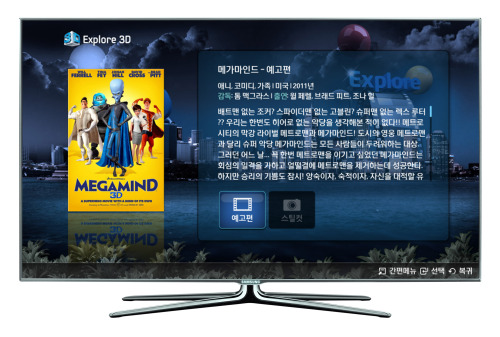Developing content will be key to success of new television sets
What’s the use of having a high-fangled 3D TV or a smart TV if there is nothing to watch?
This is a question that 30-year-old bride-to-be Kim Eun-jung keeps asking herself as she shops for appliances ahead of her wedding. Her concerns seem universal, as netizens are busily asking similar questions in online communities about whether they should be spending their dime on the new technology.
Even the cutthroat competition to secure technology superiority between the world’s top television-makers Samsung and LG will come to naught if there are no 3D contents these firms can offer to the audience, experts point out.
“The consumer expectations for 3D are becoming bigger, so it will take more than just good technology to satisfy them,” said Lee Ji-hong, a researcher for LG Economic Research Institute. “The technology needs to be backed up with the basic elements of contents.”
Although the local audience seem to be increasingly embracing the 3D wave ― largely triggered by a very persuasive Samsung and LG who are hoping to widen their consumer base for 3D and smart TVs ― the contents situation is woeful.
Both companies have signed on with entertainment firms to receive various contents, some designed for 3D and smart TVs with 3D features, but the choice that consumers have are still very narrow.
LG Electronics, for instance, currently offers almost no 3D contents of its own.
It has a contract with Sky Life, a local digital satellite broadcaster, on a strategic tie-up for jointly investing in developing 3D contents, but the deal has yet to unleash a storm of contents to choose from.
Samsung has a similar contract with DreamWorks, and also a number of other IT partners such as cable operator Comcast. So far, there has been not much of progress, but it says this year will be different.
 |
Samsung’s smart TV featuring the 3D animated film “Megamind.” (Samsung Electronics) |
By the end of this year, Samsung Electronics said it would be offering some 50 types of 3D contents, according to Yoon Boo-keun, the head of the firm’s visual display unit, in a recent media interview. Ultimately, it will be a race for securing more 3D contents, he said.
The 3D TV market was about 3 million units as of last year, but Samsung expects the market to grow to around 17 million this year.
Reflecting the surging demand, Dreamworks has said it would be manufacturing all of its animation films in 3-D. Walt Disney also said it plans to churn out some 22 of 3D films.
James Cameron, the celebrity-status director of Avatar, the movie released last year that signaled the start of the 3D entertainment era, said he is getting ready to release the 3D version of his 1997 film “Titanic” next year.
Figures from LG Economic Research Institute showed why Hollywood was so eager to jump on the 3D bandwagon.
Only 3 percent of the movies released in Hollywood were for 3D viewing in 2009, but the revenues they raised amounted to over 10 percent of the total, according to Lee Ji-hong of LG Economic Research Institute.
“Eventually, we believe there will be more 3D contents out there, because that is the direction we have to go to, but it is true that the choices are very limited as of now,” said Kim Choon-gon, a spokesman for Samsung.
He added that due to cost reasons, Samsung is unlikely to venture into developing contents of its own.
“It makes more financial sense to form alliances with other developers of such contents, rather than try to do it ourselves,” Kim said.
Meanwhile, as consumers lament the lack of contents, Samsung and LG had until recently been locking horns over whose 3D technology is superior.
LG Electronics’ latest lineup of 3D TVs was unveiled last month to much anticipation about its new film-type patterned retarder technology that it claimed reduces much of the side-effects of 3D vision, such as flickering and crosswalk.
The 3D eyewear also has become lighter and easier to wear, LG said. Samsung refuted the claims and picked fault at the picture quality of LG’s 3D TVs, saying the markets will decide the winner.
On March 19, an online group committed to testing and evaluating electronics products, is expected to hold a demonstration to compare the two products from Samsung and LG.
By Kim Ji-hyun (
jemmie@heraldcorp.com)







![[Today’s K-pop] Blackpink’s Jennie, Lisa invited to Coachella as solo acts](http://res.heraldm.com/phpwas/restmb_idxmake.php?idx=644&simg=/content/image/2024/11/21/20241121050099_0.jpg)
